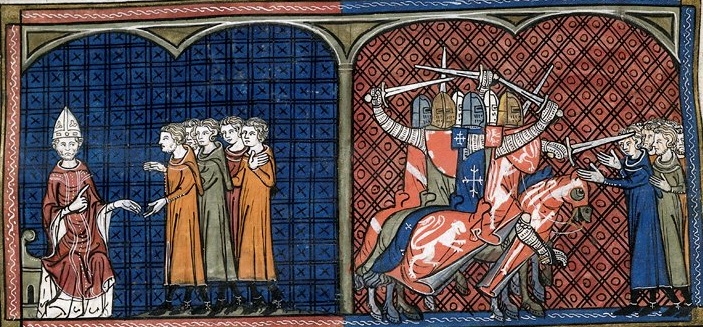In the year 1209, Pope Innocent III’s crusade against the “heretical” Cathars of southern France was launched. At the same time, the pope blessed Francis of Assisi’s proposal for a new religious order, to be guided by a “Rule”, based on teachings taken directly from the Gospel. It was to be a life of poverty and simplicity like Jesus and his apostles.
 Pope Innocent III excommunicating the Cathars (left),Massacre against the Cathars by the crusaders (right),
Pope Innocent III excommunicating the Cathars (left),Massacre against the Cathars by the crusaders (right),
Chroniques de Saint-Denis. Created: 14th Century(after 1332, before 1350). (British Library, Royal 16 G VI f. 374v)
To Innocent III, the crusade and Francis’ spiritual initiative were two sides of the same coin: his aim was to re-invigorate the Catholic Church. It had been losing ground to rival spiritual movements within Christian Europe for decades, of which the Cathars were the largest and most threatening. The Church’s last attempt to stem the tide of the advance of Islam had ended in fiasco, with the Fourth Crusade of 1204 diverted by various political and financial shenanigans from attacking the Muslims in the Holy Land to sacking the great Christian city of Constantinople (modern Istanbul). And lastly, the Catholic Church itself was in no fit state to take on these multiple challenges, facing as it did ignorance and negligence within much of its priesthood, and corruption and greed in the higher ranks. Indeed, Pope Innocent III himself had said of one of the leading churchmen in southern France:
“The Archbishop of Narbonne knows no other God than money, his heart is a bank.”
The Cathars, by contrast, were known for their integrity, spirituality and poverty, seeking to follow in the footsteps of Jesus and his apostles, and their example attracted many supporters, including within the southern French nobility. St. Bernard of Clairvaux, the great Catholic reformer and co-founder of the Knights Templar, who fought “heretics” all his life, had to admit:
"Examine their mode of life, you will find nothing more irreproachable."
Francis, therefore, with his high moral standards and devotion to the apostolic life, seemed the perfect solution. He and his friars set an excellent example for clergy and congregation alike, following as they did, model lives of humility and holiness, matching anything the Cathars could offer, whilst being doctrinally entirely orthodox, faithful to the Church and obedient to the Pope. What was not to like?
.jpg)
St. Francis of Assisi, by the master Cimabue (1240-1301) in the lower basilica of Assisi
So, on the surface, the battle lines were clearly drawn: St Francis, the Pope and the Catholic Church on the one side. The rag-bag collection of “heretics” including the Cathars on the other. But on closer examination all was not what it seemed...
First, it turned out St. Francis and his followers were something of a double-edged sword. He and his band of brothers (later sisters) were successful – too successful. They ruffled feathers amongst the established monastic orders and regular clergy, who were losing followers to him. There were complaints. The pope had to intervene. In the decades that followed, almost the reverse problem occurred: a second generation of less committed Franciscans found ways round the rigours of Francis’ Rule. The movement was becoming increasingly part of the establishment. Later popes did not share Francis’ belief in the spiritual value of poverty. His strict Rule on this issue was subject to Papal “reinterpretation”. Those Franciscans who sought to stay faithful to the original vision started to find themselves out in the cold. They were divisions, disputes, even accusations of heresy. What started off as a solution became just another problem for the Church.
All this could have been foreseen. Improving standards in the Church was one thing but St Francis’ vision was far more radical. Though he was at pains never to criticise the Church or its clergy, his way of life was a devastating if silent rebuke to the power-games and materialism of the Christian hierarchy.
This brings us to the second issue: the doctrines and practice of the Franciscans and Cathars. The Catholic Church, standing on shaky ground when it came to criticising the Cathar way of life, focused on their doctrinal “errors”. To the religious authorities, having the “right” beliefs was all important. Yet by contrast, if we look at the daily lives of the Franciscans and their “heretical” opponents, we find they held much in common.
For example, the Cathar Bishop Guilabert of Castres said of his spiritual life:
“Gold and silver I no longer carry in my purse. I am satisfied with each day’s food and am not anxious whether tomorrow I shall have enough to be clothed and fed. You see me in the teachings which Jesus Christ preached and in which His Gospel consists.”
St Francis echoes this in his Rule that governed the behaviour of his friars:
“The brothers should all strive to follow the humility and poverty of our Lord Jesus Christ, and remember that we deserve nothing else in the world except what the apostle says: ‘if we have food and clothing, we will be content with these.’”
So at a spiritual level, we see not rival faiths, still less enemies, but souls drawing their inspiration from the same vision: to be faithful to the life that Jesus showed humanity. One group operated outside the Church, one group inside it, but essentially both were carrying the same message. Francis never engaged in doctrinal disputes with the Cathars, even though they were some in his home town of Assisi. And when the Franciscans first arrived in Paris, the Church authorities initially mistook them for Cathars and it needed a letter from the Pope to confirm their orthodoxy. Spiritually, St Francis and the Cathars were on the same side.
And so it was that the year 1318 witnessed four Franciscan friars being burnt at the stake for insisting that they stick to the original Rule of St Francis, in defiance of a papal order. Three years later, the last Cathar ‘parfait’(priest) in southern France was also burnt at the stake: at the hands of the Inquisition, like the four friars.
In the end both these friars and the Cathars remained faithful to the spirit of Christ’s message and paid the ultimate price to do so.
Sunrise over the Corbières, an old Cathar stronghold in southern France.
By Simenon Honoré
If you want to find out more about the Cathars, why not watch our YouTube Playlist:
Spirit of the Rainbow: The Cathars.
If you enjoyed this article, share it with a friend.
Not yet signed up for our newsletter? It only takes a minute, here.
Popular posts
You might also like
Email Newsletter Our latest articles and offers delivered straight to your inbox.
Our latest articles and offers delivered straight to your inbox.